How It All Began – the birth of visual communication
While radio was marking its place in American households, inventors were attempting to transfer a radio broadcast into an image based media. San Francisco was the home to the first image-based media in 1927. The SF History Center provides us with a little insight in Philo T Farnsworth and his television. At 14 he envisioned a television screen as lines of a picture that when pieced together would form a visual image. For the next seven years he would think of nothing else. He finally found small financial backing and then the real work began. He knew he had succeeded when he was able to transfer an image from one room to the other; however, he was a long way from a product that was actually marketable. Unfortunately Farnsworth would not financially benefit from his idea. It wasn’t until 2002 that he was finally recognized as “the inventor of electric television.”
Now that America had an actual television, it needed a television station. In 1928, W3XK was aired in Washington, DC. It wasn’t until 1932 that the station had regular programming. Television manufacturers were a long way from selling their product to households. It was one thing to have a product and a station from which programs could be aired, and another to make the product affordable for American households. GE designed a television with a three inch screen and had every intention to make it available to the public. They quickly changed their minds realizing America could not afford their sets and it was just not to the quality the company wanted to be branded for. Companies and individuals spent the next 10 years trying to get the design right and affordable for America.
At the 1939 New York World’s Fair President Franklin Roosevelt made a live broadcast from NBC’s station (W2XBS). 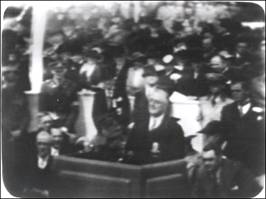 The next few years CBS, WNBC, and WCBS would follow suit. By 1946 the war is over, and six television stations are regularly on air, with more to follow. Looks like America has another viral media on its hands. After the war, American television exploded. News broadcasts occurred daily, sitcoms and cartoons were taped and aired almost immediately. There was a new advertising media in America and businesses wanted their piece of it. The first legal television commercial occurred in July 1941 for Bulova watches. Bulova paid $9 for its 10 second commercial.
The next few years CBS, WNBC, and WCBS would follow suit. By 1946 the war is over, and six television stations are regularly on air, with more to follow. Looks like America has another viral media on its hands. After the war, American television exploded. News broadcasts occurred daily, sitcoms and cartoons were taped and aired almost immediately. There was a new advertising media in America and businesses wanted their piece of it. The first legal television commercial occurred in July 1941 for Bulova watches. Bulova paid $9 for its 10 second commercial.
Like radio, television shaped the way American businesses communicated to consumers. By the 1950s two-thirds of America’s households had a television. Families referenced the TV Guide looking for their favorite program. The relationship between TV Guide and the television is a perfect example of print advertising and electronic media working together to build company branding.

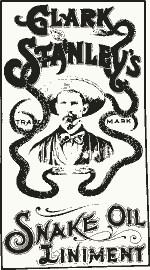
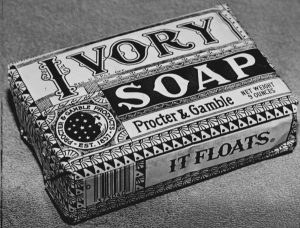 Now that printing on paper was a necessity and becoming common practice, P&G took a gamble and printed a simple design on white paper and began packing their product for mass usage. The majority of the $11,000 was spent on product packaging. The gamble paid off.
Now that printing on paper was a necessity and becoming common practice, P&G took a gamble and printed a simple design on white paper and began packing their product for mass usage. The majority of the $11,000 was spent on product packaging. The gamble paid off.
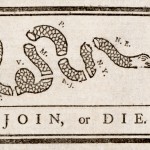 With the invention of paper and its journey to America, advertising found a new transportable method of communication. Paper became useful in newspapers, handbills, flyers, posters, and many more communications. Benjamin Franklin used his Pennsylvania Gazette to voice his opinions, under an alias of course, printed the first political campaign ad, and paved the way for future advertising.
With the invention of paper and its journey to America, advertising found a new transportable method of communication. Paper became useful in newspapers, handbills, flyers, posters, and many more communications. Benjamin Franklin used his Pennsylvania Gazette to voice his opinions, under an alias of course, printed the first political campaign ad, and paved the way for future advertising.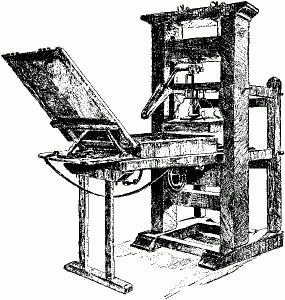 Prior to establishment of the Federal Trade Commission’s regulations in 1914 advertising was in many instances crude, one-sided, slanderous, racist, and included false information. The passing of the
Prior to establishment of the Federal Trade Commission’s regulations in 1914 advertising was in many instances crude, one-sided, slanderous, racist, and included false information. The passing of the 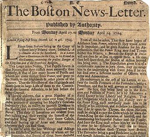 Shortly after, on October 2, 1729 Benjamin Franklin and his colleague purchased the local newspaper, and changed the name to Pennsylvania Gazette which included a “new advertisements” section. Franklin followed up in 1742 with the General Magazine which included ads as well. Franklin initiated a viral media – the development of print advertising. Of course this medium fell under the name of “newspaper”, but other printers followed his lead with their own newspaper versions.
Shortly after, on October 2, 1729 Benjamin Franklin and his colleague purchased the local newspaper, and changed the name to Pennsylvania Gazette which included a “new advertisements” section. Franklin followed up in 1742 with the General Magazine which included ads as well. Franklin initiated a viral media – the development of print advertising. Of course this medium fell under the name of “newspaper”, but other printers followed his lead with their own newspaper versions.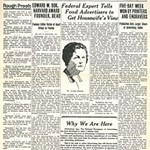 Salesmen held fast during the crash and began to feel the relief in the 1930s when Chicago launched the Advertising Age, and Life magazine published its first edition to later claim $100 million in annual advertising.
Salesmen held fast during the crash and began to feel the relief in the 1930s when Chicago launched the Advertising Age, and Life magazine published its first edition to later claim $100 million in annual advertising.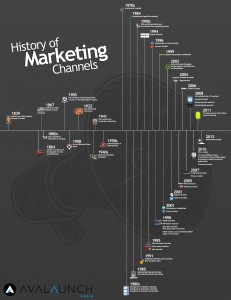


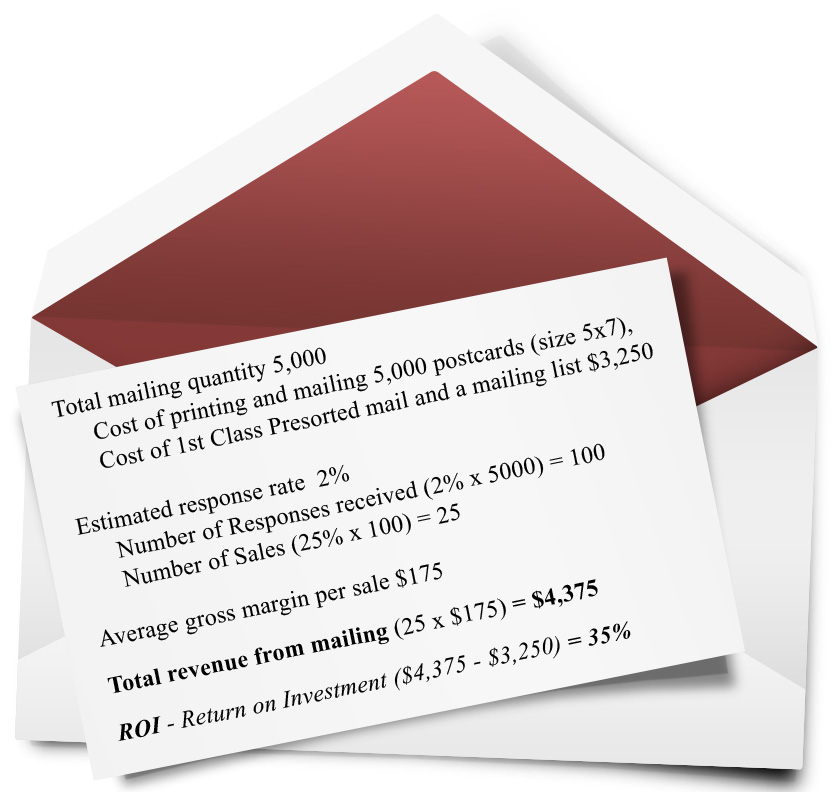 At first glance, 100 responses out of 5,000 postcards hardly seem worthwhile. But, suppose those responses resulted in 25 sales worth $4,375. Look again—those 25 sales generated a profit of $1,125 and an ROI of 35% after subtracting the cost of the direct mail campaign.
At first glance, 100 responses out of 5,000 postcards hardly seem worthwhile. But, suppose those responses resulted in 25 sales worth $4,375. Look again—those 25 sales generated a profit of $1,125 and an ROI of 35% after subtracting the cost of the direct mail campaign.